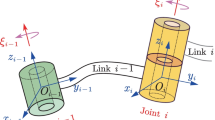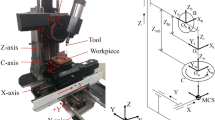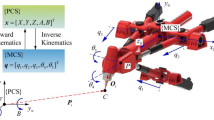Abstract
Singularities in five-axis machining are a series of positions where the exact motion of the rotary axis becomes unpredictable or incalculable. In the neighborhood of a singular point, machining may cause unstable movements of drive axes and deteriorative dynamic performance of machine tools. In this paper, we proposed a closed-loop inverse kinematics method to solve accurately the five-axis joints’ parameters around singular points. To achieve this purpose, the damped Jacobian pseudoinverse algorithm is introduced and the machine joints’ velocities are calculated directly by the velocities of the five-axis cut points. The joints are then obtained by integrating the corresponding velocities. Furthermore, a feedback control method is applied to reduce the integrating error. In the end, simulations and experiments’ results demonstrated the effectiveness of the closed-loop inverse kinematics method.

















Similar content being viewed by others
References
Affouard A, Duc E, Lartigue C, Langeron JM, Bourdet P (2004) Avoiding 5-axis singularities using tool path deformation. Int J Mach Tools Manuf 44(4):415–425
Yang J, Altintas Y (2013) Generalized kinematics of five-axis serial machines with non-singular tool path generation. Int J Mach Tools Manuf 75:119–132
Wan M, Liu Y, Xing WJ, Zhang WH (2018) Singularity avoidance for five-axis machine tools through introducing geometrical constraints. Int J Mach Tools Manuf 127:1–13
Liu Q, Huang T (2019) Inverse kinematics of a 5-axis hybrid robot with non-singular tool path generation. Robotics and Computer-Integrated Manufacturing 56:140–148
Sun S, Sun Y, Lee YS (2019) A gouge-free tool axis reorientation method for kinematics compliant avoidance of singularity in 5-axis machining. J Manuf Sci Eng 141(5)
Yuwen S, Jinjie J, Jinting X, Mansen C, Jinbo N (2022) Path, feedrate and trajectory planning for free-form surface machining: a state-of-the-art review. Chinese J Aeronaut 35(8):12–29
Lin Z, Fu J, Shen H, Gan W (2014) Non-singular tool path planning by translating tool orientations in c-space. Int J Adv Manuf Technol 71(9):1835–1848
Lin Z, Fu J, Yao X, Sun Y (2015) Improving machined surface textures in avoiding five-axis singularities considering tool orientation angle changes. Int J Mach Tools Manuf 98:41–49
Lin Z, Fu J, Shen H, Xu G, Sun Y (2016) Improving machined surface texture in avoiding five-axis singularity with the acceptable-texture orientation region concept. Int J Mach Tools Manuf 108:1–12
Cripps R, Cross B, Hunt M, Mullineux G (2017) Singularities in five-axis machining: cause, effect and avoidance. Int J Mach Tools Manuf 116:40–51
Yang J, Aslan D, Altintas Y (2018) Identification of workpiece location on rotary tables to minimize tracking errors in five-axis machining. Int J Mach Tools Manuf 125:89–98
Pessoles X, Landon Y, Segonds S, Rubio W (2013) Optimisation of workpiece setup for continuous five-axis milling: application to a fiveaxis bc type machining centre. Int J Adv Manuf Technol 65(1):67–79
Gao S, Zhou H, Hu P, Chen J, Yang J, Li N (2020) A general framework of workpiece setup optimization for the five-axis machining. Int J Mach Tools Manuf 149:103508
Munlin M, Makhanov SS, Bohez EL (2004) Optimization of rotations of a five-axis milling machine near stationary points. Computer-Aided Design 36(12):1117–1128
Shen H, Fu J, Lin Z (2015) Five-axis trajectory generation based on kinematic constraints and optimisation. Int J Comput Integr Manuf 28(3):266–277
My CA, Bohez EL (2016) New algorithm to minimise kinematic tool path errors around 5-axis machining singular points. Int J Prod Res 54(20):5965–5975
Sørby K (2007) Inverse kinematics of five-axis machines near singular configurations. Int J Mach Tools Manuf 47(2):299–306
Gray PJ, Ismail F, Bedi S (2007) Arc-intersect method for 31212-axis tool paths on a 5-axis machine. Int J Mach Tools Manuf 47(1):182–190
Grandguillaume L, Lavernhe S, Tournier C (2016) A tool path patching strategy around singular point in 5-axis ball-end milling. Int J Prod Res 54(24):7480–7490
Ben-Israel A, Greville TN (2003) Generalized inverses: theory and applications. Springer Science & Business Media 15
Nakamura Y, Hanafusa H (1986) Inverse kinematic solutions with singularity robustness for robot manipulator control. J Dyn Syst Meas Control 108(3):163–171
Wampler CW (1986) Manipulator inverse kinematic solutions based on vector formulations and damped least-squares methods. IEEE Trans Syst Man, and Cybern 16(1):93–101
Chiaverini S, Egeland O, Kanestrom R (1991) Achieving user-defined accuracy with damped least-squares inverse kinematics. In: Fifth International Conference on Advanced Robotics’ Robots in Unstructured Environments, pp. 672–677. IEEE
Wampler C, Leifer L (1988) Applications of damped least-squares methods to resolved-rate and resolved-acceleration control of manipulators. Journal of Dynamic Systems, Measurement, and Control 110(1):31–38
Siciliano B, Sciavicco L, Villani L, Oriolo G (2009) Differential kinematics and statics. Robotics: Modelling, Planning and Control, 105–160
Colomé A, Torras C (2014) Closed-loop inverse kinematics for redundant robots: comparative assessment and two enhancements. IEEE/ASME Transactions on Mechatronics 20(2):944–955
Funding
This project is supported by Scientific Research Projects of Colleges and Universities in Anhui Province (No.2022AH051037) and the National Natural Science Foundation of China (Grants No. 12001028, No. 62102013, and No. 62141605).
Author information
Authors and Affiliations
Contributions
All authors contributed to the study’s conception and design. Material preparation and data collection were performed by Zehong Lu. Analysis was performed by Zehong Lu, Guanying Huo, and Xin Jiang. The first draft of the manuscript was written by Zehong Lu and all authors commented on previous versions of the manuscript. All authors read and approved the final manuscript.
Corresponding authors
Ethics declarations
Competing interests
The authors declare no competing interests.
Additional information
Publisher's Note
Springer Nature remains neutral with regard to jurisdictional claims in published maps and institutional affiliations.
Rights and permissions
Springer Nature or its licensor (e.g. a society or other partner) holds exclusive rights to this article under a publishing agreement with the author(s) or other rightsholder(s); author self-archiving of the accepted manuscript version of this article is solely governed by the terms of such publishing agreement and applicable law.
About this article
Cite this article
Lu, Z., Huo, G. & Jiang, X. A novel method to minimize the five-axis CNC machining error around singular points based on closed-loop inverse kinematics. Int J Adv Manuf Technol 128, 2237–2249 (2023). https://doi.org/10.1007/s00170-023-11991-0
Received:
Accepted:
Published:
Issue Date:
DOI: https://doi.org/10.1007/s00170-023-11991-0




